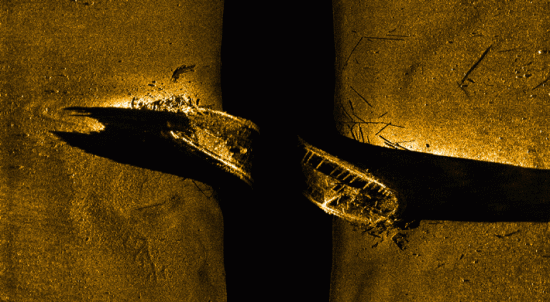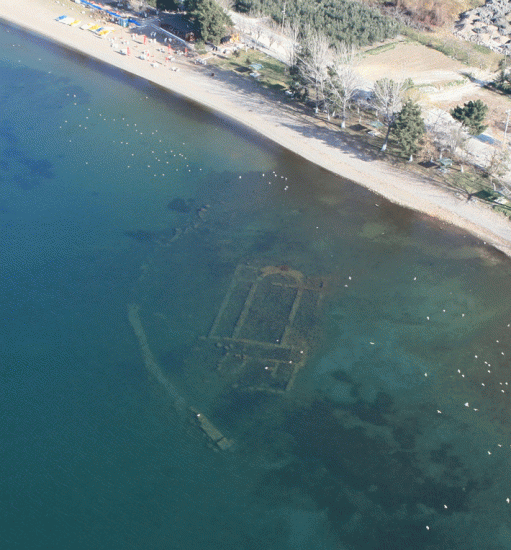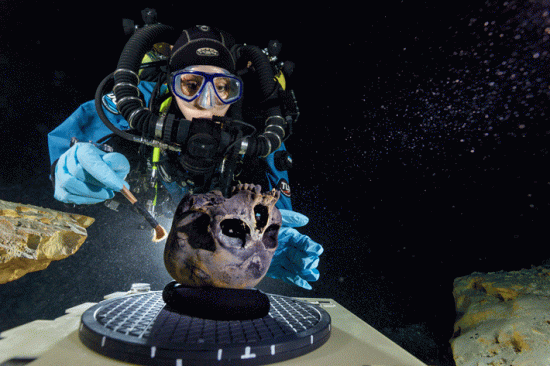PART.2
Erebus , Victoria Strait (Canada)
Samir S. Patel

(Courtesy © Thierry Boyer, Parks Canada)
Rare is the archaeological discovery that gets announced by a head of state. But the discovery of a shipwreck in frigid Arctic waters got just that treatment in September from Canadian Prime Minister Stephen Harper. “I am delighted to announce that this year’s Victoria Strait Expedition has solved one of Canada’s greatest mysteries,” Harper’s statement reads, “with the discovery of one of the two ships belonging to the Franklin Expedition lost in 1846.” Sir John Franklin commanded the two ships—HMS Erebus and Terror—that sailed from England in May 1845 to search for the Northwest Passage. The ships’ disappearance with no trace led to three decades of searches by land and sea, which themselves claimed several ships, including HMS Investigator, discovered in 2010 (“Saga of the Northwest Passage,” March/April 2012). More recently, another three decades were spent excavating sites on nearby islands and searching for the wrecks with sonar, capped by this year’s Parks Canada–led expedition. Three weeks after the announcement, archaeologists confirmed that the ship is Erebus, the one that had been captained by Franklin himself, and reported that it is in remarkable shape. The discovery is more than just the solution to a mystery, though: Harper connects the wreck to Canada’s claim of sovereignty over vast portions of the Arctic—and the massive oil, gas, and mineral reserves they appear to hold.
Lake Iznik (Turkey)
Eric A. Powell

(Mustafa Sahin/Uludag University)
Only 100 miles from Istanbul, the ancient city of Nicaea, on the shores of Turkey’s Lake Iznik, is not remote or unknown. So archaeologist Mustafa Sahin was in for a shock when a routine aerial survey of the lake revealed traces of a fifth-century basilica. “I did not believe my eyes when I saw it under the helicopter,” says Sahin. “I thought to myself, ‘How did nobody notice these ruins before?’” The site is now slated to become an underwater archaeological museum.
Badari (Egypt)
Daniel Weiss

(Courtesy © Ron Oldfield and Jana Jones)
Analysis of funerary wrappings that have been stored in Britain’s Bolton Museum since the 1930s has established that Egyptians cooked up recipes to mummify the dead as early as 4300 B.C.—1,500 years earlier than previously thought. The linen wrappings came from cemeteries in the Badari region of Upper Egypt and date to well before the beginning of rule by pharaohs. Stephen Buckley, an archaeological chemist at the University of York, found that the wrappings were permeated with a mixture of pine resin, an aromatic plant extract, a plant gum or sugar, a plant oil or fat, and a natural petroleum source. “The recipes being used were essentially the same embalming recipes that were used 3,000 years later,” says Buckley, “when the art of mummification was at its height.” Buckley’s analysis also revealed that early Egyptians were part of a far-reaching trade network. The chemical signature of the pine oil in the embalming mixture suggests that its closest source would have been in modern-day Turkey. Intriguingly, the earliest wrappings include chemical components typical of sea sponges. Buckley argues that sponges may have been included in the recipe because they have the ability to regenerate after a part is removed, and Egyptians likely had observed that. Rebirth was the goal of mummification in the pharaonic period, and it seems that it was in earlier times as well. Interestingly, these early attempts at mummification only involved wrapping the head, hands, and feet. Later on, to improve preservation, it became common practice to wrap the entire body after removing the internal organs and adding natron, a salt that helped dry out the remains.
Køge (Denmark)
Zach Zorich

(Courtesy The Danish Castle Center, Linen)
In a field southwest of Copenhagen, beneath a barely perceptible rise, lies what’s left of a fortress that may have been built by Harald “Bluetooth” Gormsson, the tenth-century Viking warrior who became the first king of Denmark. This is the first such fortress to be found in the country in 60 years. Archaeologists used remote-sensing surveys to identify the 475-foot-wide circular structure as well as buildings and pits in and around it. They also excavated two of the fort’s gates and found burned timbers in both, which could suggest that the fortress had been attacked. It is also possible that it was burned when it was no longer needed. There are four other known Viking fortresses in Denmark, all dating to around A.D. 981, during the reign of Bluetooth, and they all have the same layout. This one is providing a new opportunity to learn about the reign of the king who Christianized Denmark and implemented a national government. “It was an amazing time,” says Nanna Holm of the Danish Castle Center. “It is when we became who we are today.”
Naia - Yucatán Peninsula (Mexico)
Nikhil Swaminathan

(Paul Nicklen/National Geographic)
The 1996 discovery of the 9,000-year-old remains of a hunter—known as Kennewick Man—near the Washington-Oregon border presented an intriguing puzzle to archaeologists studying the peopling of the Americas. While he was clearly an early American, he had a larger skull and a narrower face that projected farther forward than those of modern Native Americans. These physical discrepancies led scientists to question whether he was a direct ancestor of modern Native Americans, or if a different group of people migrated to the Americas and gave rise to them. An answer might have been found in a 150-foot-deep water-filled trench known as Hoyo Negro (“black hole”) in an underwater cave system in Mexico’s Yucatán. There, in 2007, divers found the nearly intact skeleton of a 15- to 16-year-old girl they called Naia (for the Greek water nymph). This year, scientists announced what Naia’s remains revealed. Multiple methods used to date her teeth and bones suggests that she lived between 12,000 and 13,000 years ago, making her one of the earliest humans ever found in the Americas. Analysis of her mitochondrial DNA, which is passed from mother to child, show that she had a constellation of genes that is common among modern Native Americans. Her skull construction is also similar to that of Kennewick Man. “She has the physical characteristics we expect to see in Paleoamericans, and the genetics say she and modern Native Americans share ancestry,” says James Chatters, an archaeologist who has studied both Naia and Kennewick Man. These two ancient Americans—and modern Native Americans—can likely all trace their heritage back to the same source population, a group that is thought to have been isolated for thousands of years in Beringia, the land mass that once connected Asia and the Americas. Researchers now believe that adaptations over the past 13,000 years in the Americas produced changes in appearance, leading to the features we commonly see among today’s Native Americans.